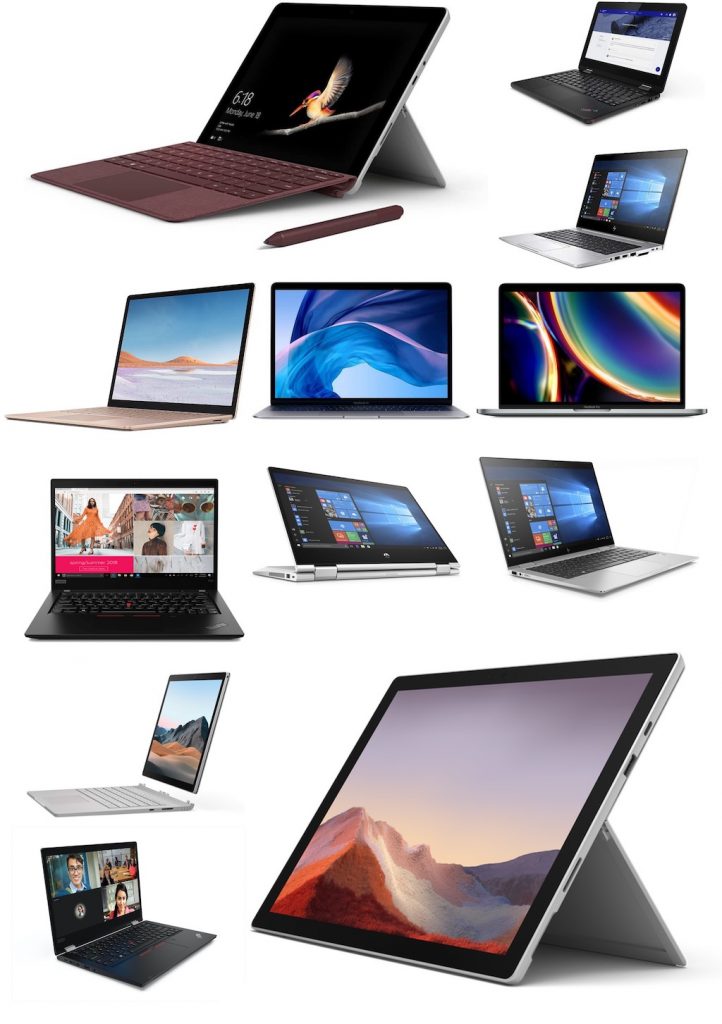What we have learned from 20 years of 1:1 Programs
While COVID lockdowns have placed more emphasis on digital learning, the implementation of one device per student across schools has a long history – one that Winthrop has been part of since the beginning. While the devices may have changed, some challenges persist and many of the lessons are just as relevant today as they were a decade ago. In this article we reflect on the last two decades and draw out some of the key lessons for schools.
When it comes to key decision about 1:1 programs historically one of the biggest was the choice between Apple and Windows platform. Both camps have their ardent supporters and once a school had made their selection, they generally stuck with it. Although the two platform options were available, the majority of Secondary Schools historically chose a Windows devices. While adoption of devices in Primary Schools came later than in Secondary Schools, initially the only viable option was the Apple iPad. Applications sat on the device and application developers for schools then prioritised the dominant platform, which reinforced these market positions.
While history and the ongoing legacy continues to play a key part in the schools choice of platform, another factor behind this trend is that in primary school the device is generally used to consume content, while in secondary school the device which has greater power and functionality is generally used to create content. Budget is also a major consideration. With primary schools having smaller budgets and curriculum being more focused on content consumption, iPads and more recently Chromebooks are the most widely used devices. Whereas the emphasis on content creation in secondary school makes MacBooks & Higher spec Windows devices the more common choice. As the years have passed the platform has become less relevant with many applications able to work across the range, many applications now hosted. While the majority of schools still tend to choose one path, and both paths are good choices, some have successfully introduced environments where a mix coexists comfortably, and the platform is chosen based on specific requirements for year levels and subjects.
Which brings us to one of the first key lesson of 1:1 programs – the ticket price of the device should not be the major driver in the choice of device.
Lesson One – Avoid False Economy
Any 1:1 program device should last the student at least three years, so the cost of ownership needs to be assessed across three years, rather than just at the point of purchase. Related to this, is whether or not the device is fit for purpose longer term – another way of looking at this is to consider the question, ‘will the device being purchased at the start of year seven be capable of meeting the demands of a year 9 student three years from now?’ There are three key elements to resolving this question: specifications, quality and support.
- Specifications: it is important to understand IT trends and set the specifications bar high enough that the device will still be capable of delivering a productive user experience three years into the future.
- Quality: students are to computers what taxi drivers are to cars – as a rule of thumb over the same period a student will have twice as much wear and tear on a computer as an office user. Subsequently the build quality and durability matter more for student devices.
- Support: the support goal should be to minimise downtime. Which is why the source of support matters as least as much as the warranty/ accidental damage cover. The warranty and accidental damage cover will help you financially, but it is the source of support that will determine how long it takes to get the device working again. This is a major trap for families when sourcing their bring-your-own-device, with some devices having return-to-manufacturer warranty support conditions that not only result in long turn around times, but also potentially result in data loss. (Top tip: Only purchase from a supplier that is also a service provider for the device or can increase the standard support levels on your devices.)
The cost of downtime does not just apply to the individual student, it also has a ripple effect on other students and the class lesson plan – particularly when there are multiple simultaneous outages. Subsequently, if the initial saving on the device is made possible by compromising the specifications, quality, or support – then it is a false economy.
Lesson Two – Choose Wisely
In the movie The Last Crusade, a 700-year-old knight advised Indiana Jones to ‘choose wisely’, which turned out to be avoiding all the flashy options and selecting the common-man’s alternative. In 1:1 programs the wise choice is also the common choice. Taking the path less travelled might be nice on a scenic walk, but it can be fraught with danger when applied to laptop selection. This is often a difficult message to get across to students and parents that place a premium on self-expression – regardless of whether the item is an expression of wealth, artistic flair, or technical knowledge. The best way to deliver the message is frequently the Henry Ford way, i.e. “You can have any [device] you want, providing it is [X]”.
Here are four ways this can be done in order of preference:
- Buy and Supply – the school purchases and provides the devices, with the cost of the device built into the school fees. This guarantees uniformity and avoids parent debate around price and value. It also provides the school with an excellent basis for negotiating a great deal with its supplier, including onsite support and same-day repairs.
- Specify and Buy – the school chooses the device and the supplier; the family buys the device directly from the supplier. This also delivers uniformity, but can be a source of friction with parents who think they could get a better deal elsewhere (usually by sacrificing quality or support). This option also provides the school with strong supplier negotiation power.
- Limited Options – the school chooses a number of devices (usually 3 options) for the families to choose from. This is a compromise between uniformity and self-expression and is often done to cater for the inclusion of a cheaper option for lower income families. Like most compromises it is both good and bad in that although it limits the number of different devices, it fails to deliver uniformity, which in turn compromises group buying power and potentially the use of the device in the classroom.
- Spec Sheet – the school sets a minimum specification and parents are left to source a device that meets or exceeds that expectation. This is the messiest option with a wide range of devices and varied levels of warranty and support arrangements. It risks introducing both device rivalry and device incompetence into the classroom setting – two things that most teachers would rather do without.
The value of uniformity in a 1:1 program should not be underestimated. User errors can be readily addressed by classmates and teachers, and the ongoing support and repair of devices can be cost effectively arranged to minimise device related downtime.
Lesson Three – Listen to the Experts
Every field has different levels of expertise. Unfortunately, I.T. has no shortage of people willing to provide an expert opinion – so schools should look for the ones that have the data and experience to back up their opinion. Individual schools have a sample of hundreds of devices, suppliers like Winthrop have samples of tens of thousands of devices. So, we often know before the school and the manufacturer that a particular model has a problem.
We also know the most common points of failure in education devices, so much so that we can plot and predict failure rates. We do this so that we can prepare for them, ensuring we always have the relevant parts on hand to minimise downtime for our clients. Some of what we know and predict still surprises schools.
Lesson Four – Prioritise Up Time
Through every year level, we would encourage schools to prioritise up time for their 1:1 programs. It is one of the principles behind the devices remaining in the classroom in primary school so that students cannot forget to bring them to school. It is a guiding principal behind uniformed device selection and onsite support through the early years of secondary school. So, it has always been interesting to note that when students can least afford downtime, they are most exposed to it. Particularly in reference to the common practice of schools switching to Bring-Your-Own-Device, (any device), for years 10, 11 and 12.
While it is understandable that as students choose different disciplines their device requirements will vary accordingly. However, abandoning standardisation entirely makes it impossible for the school and the school’s supplier to provide the same level of cost-effective on-site support, data recovery and device repair, that underpinned the students’ digital learning through the earlier years. Perhaps more schools will rethink this approach and offer a more limited range of options that can be fully supported, while also catering for different study paths – be they graphic design, computer programming, the sciences or humanities.
Conclusion
Twenty years has seen an incredible development in the capability of 1:1 devices, and the ways in which they are integrated into education. While it has long been predicted, perhaps computer-based exams in year 12 are now closer than ever before. One thing that has remained constant is the importance of ensuring students are able to get the most out of their digital education. A good 1:1 program requires that schools aim to avoid false economy, choose wisely, listen to the experts, and prioritise uptime.
About the Author
Winthrop National Education Manager, Brett North has 20 years’ experience in providing 1:1 programs to schools.
Quiz Time
Fancy a trip through personal computer history? Test your laptop and tablet historical knowledge. Click Here to take our quiz.




